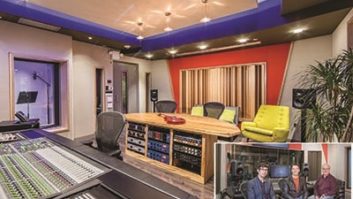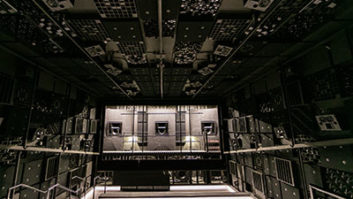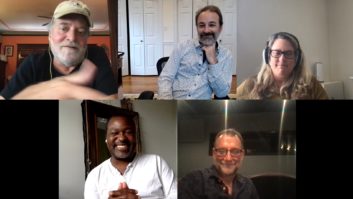On the “Design Meets Reality” panel were (l-r): Dominic Sack; Scott Leher; Collie Bustin; Christopher Sloan; Paul Garrity; and moderator Christopher Evans. With the 135th AES Convention held in New York City only blocks away from Broadway, the best-known theatrical district in the world, it only made sense for the Live Sound Track of last fall’s Convention to take advantage of that proximity and present insights and knowledge from the city’s top theatrical live sound pros.

On hand for the panel, “Design Meets Reality: The A2s and Production Sound Mixer’s Challenges, Obstacles and Responsibilities for Loading in and Implementing the Sound Designer’s Concept,” were moderator Christopher Evans, Benedum Center; Collie Bustin, Ires-Partners; Paul Garrity, Auerbach and Associates; Dominic Sack, Sound Associates; Scott Leher, Scott Leher Sound Design; and Christopher Sloan, production engineer, The Book of Mormon.
Discussing designing installed theatrical house systems, Garrity noted, “We try to spec equipment that will work for the house, but be familiar enough for the people coming in on the tours so they can look at it and say, ‘Oh I can use that.’ We want to make a great system where [visiting productions] will say ‘Good, I can leave my stuff on the truck.’”
Creating a high performance and guest-engineer friendly system eases the process when the using house gear is the only choice. Sack recalled the moment when he heard about a production carrying Sound Associates equipment was being loaded into moderator Evans’ Benedum Center in Pittsburgh, PA: “I got a picture sent to me on my cell phone of the Mary Poppins speaker towers and they had fallen off a forklift a good eight feet; they were completely mangled. Chris and I had put in a Meyer M’elodie system in the Benedum Center a few years earlier and it saved the show. It just so happened that Mary Poppins was touring with 16 M’elodies per side in groups, so the whole show was maintained as best it could. The sensitivity of the inputs stayed the same, and they were able to do a show, which would have cost everyone tremendous amounts of money if they had to bring it in, fly it, get it up there. That also speaks to not getting too esoteric with the house designs.”
Continuity of information within a theater was a big topic, with Sloan remarking, “One thing I’ve found in years of touring is a real information disconnect between the design phase, the construction phase and the implementation. It usually comes to the labor because people come and go from these jobs and information is lost, plus there’s never an awful lot of training that goes on when the system is turn-key. Another thing is maintenance, because a group comes through, blows a bunch of speakers, goes home and next week, a crew comes in, turns it all on and nobody knows or cares that they got blown.”
Evans beat the drum for spending the money for experienced engineers, noting, “The touring engineers and house engineers are a good investment. A lot of good road engineers aren’t touring anymore and they don’t bring that expertise to a show that can save a producer money. I see systems go out on some of these large road shows and they have an engineer fresh out of school, who has never toured, is scared to death, and can’t make a decision—and that’s more than 50 percent of productions now.”
“Absolutely,” concurred Bustin. “We’ve seen packages get larger over the last few years and the engineers get less and less experienced, so the pay scales go down. And on a touring and venue level, the two biggest restricting factors in moving a show around this country in maintaining design in quality and level of product is time and ability of the people working on the project. Load-in times are tighter and tighter, and we’re adding more automation and lighting and other people into it, and you’re putting the show in in eight hours. You have people on tour less than experienced. It’s not only about low salaries, it’s about maintaining the people you have. If you luck out and get a good person this year, you’ll have a hard time keeping them next year and the year after because [producers] look at these budgets as fixed entities; they’re not looking at giving a bump to an engineer on his second or third year, so he moves on.”
AES
Aes.com





